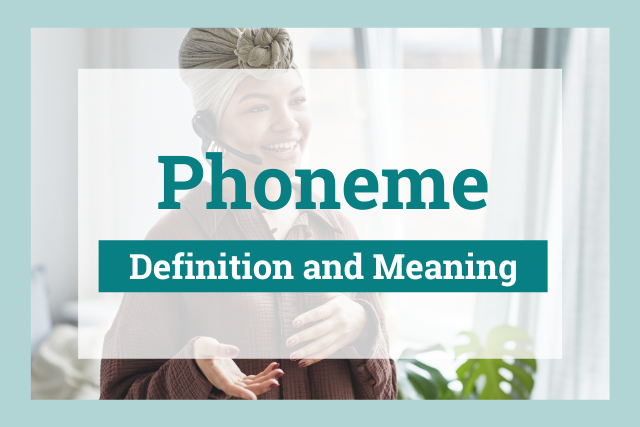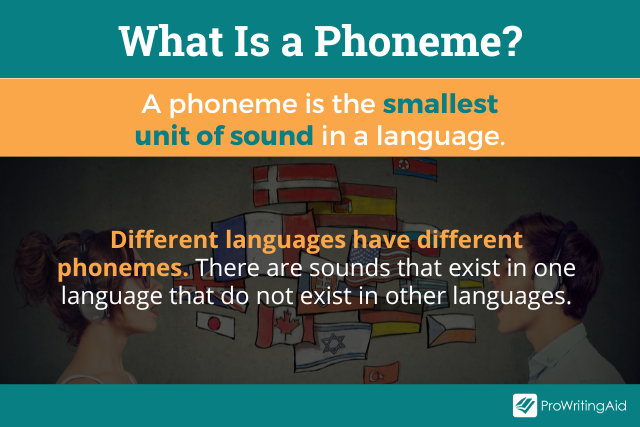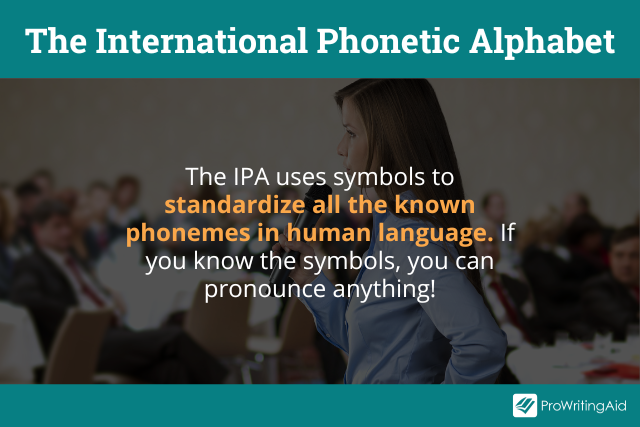
The English language consists of forty-four distinct sounds. These are called phonemes, which are the smallest unit of sound in a language.
Phonemic awareness is knowing how to pronounce words correctly in a particular language. We use different phonemes for pronunciation.
Let's take a look at exactly what a phoneme is and how to use phonemes to promote your own phonemic awareness of English.

Phoneme Definition
In the field of linguistics, spoken language is broken down into speech sounds. A phoneme is the smallest unit of sound.
These sounds combine to make other sounds, which in turn combine to make words.
The word phoneme comes from the Greek phōnēmat, which refers to an utterance made by a human or animal. The root "phone" means sound.
Different languages have different phonemes. There are sounds that exist in one language that do not exist in other languages.
What does "the smallest unit of sound" mean? Let's use a chemistry metaphor to understand how phonemes work.
In chemistry, an atom is the basic unit of matter. A phoneme is like an atom of spoken language.
Atoms combine to make molecules. Separate phonemes combine to make "blends," or combined sounds.
Molecules combine to make compounds. These phoneme blends combine to make words.
What Are Phonemes?
Phonemes only refer to sounds. They don't always match up with the letters that form them.
For example, take the words fit, phone, and laugh. These words all contain the same sound, or phoneme, /f/.
But this phoneme is written differently in each word. The letters that we use to write a phoneme are called graphemes. The root word "graph" means "writing."
In our example words, the same phoneme has three different graphemes: f, ph, augh.
Graphemes that have two consonants or vowels to make a sound are called digraphs. Ph is a digraph.

Sometimes, the same letter of the alphabet can represent more than one phoneme. Think about the letter A. It can make many different sounds.
We can write the individual sounds of phonemes as graphemes, or phonetically, like /f/. But this gets confusing.
Different languages use their alphabetic letters differently, or they might have an entirely different alphabet.
The International Phonetic Association [IPA] created the International Phonetic Alphabet in the late 1800s to help people learn how to pronounce words correctly in various languages.
It's a way to standardize each phoneme in every language.
The IPA uses unique symbols for pronunciation. If you know how to pronounce the phoneme of each symbol, you can pronounce any word in any language.

List of Phonemes
How many phonemes are there in English? It depends on who you ask. In general, there are forty-four accepted phonemes.
Some linguists divide these differently, so certain sources might say there are between forty-two and forty-six phonemes in English.
We've divided the forty-four basic phonemes into consonant sounds and vowel sounds.
Consonant Phonemes
| Phoneme | IPA Symbol | Common Graphemes | Example |
|---|---|---|---|
| /b/ | b | b, bb | bat |
| /d/ | d | d, dd, ed | dog |
| /f/ | f | f, ph | phone |
| /g/ | g | g, gg | egg |
| /h/ | h | h | ham |
| /j/ | dʒ | j, g, ge, dge | dodge |
| /k/ | k | c, k, ck | click |
| /l/ | l | l, ll | light |
| /m/ | m | m, mm, mb | mom |
| /n/ | n | n, kn | know |
| /p/ | p | p, pp | pot |
| /r/ | r | r, rr, wr | right |
| /s/ | s | s, se, c, ce | ice |
| /t/ | t | t, tt | tea |
| /w/ | w | w, wh | why |
| /y/ | j | y, i | yes |
| /z/ | z | z, zz, s, se, x | was |
| /th/ (voiceless) | θ | th | thumb |
| /th/ (voiced) | ð | th | then |
| /ng/ | ŋ | ng, n | sing |
| /sh/ | ʃ | sh, ch, ti, ci | chef |
| /ch/ | tʃ | ch, tch | lunch |
| /zh/ | ʒ | ge, s | garage |
Vowel Phonemes
| Phoneme | IPA Symbol | Common Graphemes | Example |
|---|---|---|---|
| /a/ | æ | a, au | cat |
| /e/ | e | e, ea | wet |
| /i/ | ɪ | i | if |
| /o/ | ɒ | o, a, au, aw, ough | hot |
| /u/ | ʌ | u, o | up |
| /ā/ | eɪ | a, ay, ei, ey | may |
| /ē/ | i: | e, ee, ea, ie | see |
| /ī/ | aɪ | i, igh, y | eye |
| /ō/ | oʊ | o, oa, oe | bone |
| /ū/ | u: | oo, u, ew, ue | few |
| /oo/ | ʊ | oo, u, oul | book |
| /ow/ | aʊ | ow, ou | cow |
| /oy/ | ɔɪ | oi, oy | boy |
| /a(r)/ | ə | a, er, i, ar | dollar |
| /ā(r)/ | eəʳ | air, ear, are | pair |
| /ī(r)/ | ɪəʳ | irr, ere, eer | cheer |
| /i(r)/ | ɜ:ʳ | ir, er, or, ur | her |
| /o(r)/ | ɔ: | or, ore, oor | door |
| /u(r)/ | ʊəʳ | ur, ir, er, ear | burn |
Phoneme Examples
Now, let's take some of these phonemes and see how they work to create words.
Let's start with the phoneme /k/. There are several ways to write this phoneme.
We can write it with a k, c, ck, q, cc, or even ch. Here are some words that use this phoneme:
- King
- Cat
- Check
- Bouquet
- Acclaim
- Ache
The word "king" contains three phonemes: /k/ /ē/ /ng/. The word "bouquet" is longer, but it contains just four phonemes: /b/ /oo/ /k/ /ā/.

The letter X contains two phonemes, even though it's just one letter. It's made up of the phoneme /k/ and /s/.
This means that the word "box" has four phonemes, even though it's just three letters: /b/ /o/ /k/ /s/.
It doesn't matter how many letters a particular word contains. The phonemes are the individual sounds in that word, and there might be more or fewer phonemes than there are letters.
What Are Phonemes in English?
We might have twenty-six letters in our alphabet in English, but we have nearly double the amount of phonemes.

We use letters for written communication, but speech is something else entirely.
Linguists have broken the English language into these phonemes to help people understand how to speak English correctly.
Of course, different parts of the English-speaking world pronounce words with slightly different phonemes.
There are differences in how British and American speakers use phonemes in their pronunciation.
But the divisions go even further than that. Within each English dialect—American, British, Australian, South African, etc.—there are regional accents that include different pronunciations.
Linguists might note even more phonemes within a dialect than the standard language phonemes. In other words, people from certain regions might have additional phonemes in their speech.
If you need help standardizing your written communication, use ProWritingAid to check your spelling, grammar, and syntax. It's free! Try ProWritingAid today.


